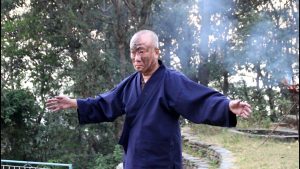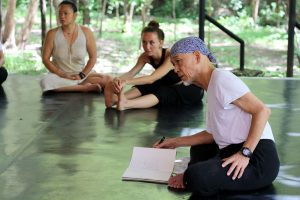Ethics (Upd: Aug 23, ’25)
“He who fights with monsters should look to it that he himself does not become a monster.” – Friedrich Nietzsche¹
As with any artistic field, ethical issues are bound to surface. Within the butoh world, the topics can range from (1) separating the art/material from the artist/teacher; (2) consent within both participants and audience; (3) cultural appropriation; and (4) animal cruelty.
Separating Art & Artist
There are cases when the personal lives of butoh artists or teachers are found to be ethically questionable. If the case then turns into the sole justification against an artwork or teaching, then it is an example of a logical fallacy known as an ad hominem. This an argument based off on attack of character instead of the subject or topic at hand.²
Despite the seemingly baseless ground of attacking the art or material, once the secret is revealed, it cannot be unrevealed. The art is affected, but the degrees will vary. If the art or teaching material is not completely denounced, it may create an extra dimension of caution or reflection.
If an instructor is discovered to have a history of abuse, this can be considered a direct conflict of interest because guiding assumes the opening of a safe environment (see examples below in Controversial Butoh Artists).
We must also be careful not to blame the whole art for the actions of one or a few individuals. Doing so would fall into another logical fallacy known as a hasty generalization, which means generating a conclusion from a small sample size.
Consent
Consent is grounded on the modern trauma-informed pedagogical ideal of foremost facilitating a safe environment to practice in or observe.³ This involves developing communication skills within the space.
Consider the following:
As a guide, for new participants, first ask or communicate before engaging in a bodily correction. Because a correction may provoke a trauma, caution is advised.
During performance, it is not recommended to invade the audience’s body-space (touching, etc.), unless they have agreed prior to it via an announcement or through signed consents. For more information, see this Dance Magazine article.
Cultural Appropriation
Hijikata and Ohno’s creation of butoh was a conglomeration of varying cultural influences which were non-Japanese such as Genet, Sartre, deSade, Artaud, Bacon, Greek tragedy, Christianity, Argentinian tango, etc.4
However, borrowing a specific culture’s identity marker (e.g. kimono, traditional mask) can be problematic to some.
Animal Cruelty
Unfortunately, the very roots of butoh have been associated with animal cruelty.
In Tatsumi Hijikata’s first performance Forbidden Colors, a chicken was killed* between Yoshito Ohno’s legs.5 Also, in the Navel and A-Bomb butoh art film by Eikoh Hosoe and Hijikata, there was a long scene of a struggling chicken with its head cut off at the beach.
Shadowbody is firmly against animal cruelty.
The Silence of Witnesses
Like in all other moments of life, harmful and/or illegal activity is bound to occur. Unfortunately, the more unpleasant side of human nature has built into it the blind eye or refusing to speak out about something awful that was witnessed. There can be a number of reasons why the blind eye occurs such as being overwhelmed enough to not say or do anything at all (like a freeze response) or the fear of social stigma. In my persona life, for instance, a few have concluded that when I spoke out about the Rhizome Lee back in 2019, it was motivated by attention or fame-seeking.
It takes courage speak out. Some things could be on the line, such as pushback, but I feel integrity and conscience should overwrite all fear of social stigma. When one is witness to something awful, a call to action occurs which is inherently already beyond one’s self—a service for community—so as to help prevent others in the future from running into the same thing.
Controversial Butoh Artists
There are two butoh artists in the world that I know of who have struck much controversy throughout the years. They are: (1) Rhizome Lee and (2) Katsura Kan.
Note: Although I have a conflict of interest, having personally known and studied under Rhizome Lee, I will present the information as neutrally and honestly as possible, adhering strictly to what has occurred to me even if some of the things cannot be proven.
Rhizome Lee (of Subbody)

In August of 2019 during the Sesalac Butoh Festival in Sesalac, Serbia (also called Serbia Butoh Festival), one Subbody peer (anonymity kept), gathered all the other Subbody peers at the festival to claim that Rhizome Lee (real name Ryuji Oka) had been sexually inappropriate not only to her but to other Subbody peers.
The reaction was met with both shock and skepticism. The following month, I returned to Dharamsala (India), and on September 18 with Turkish butoh artist Özerk Sonat Pamir as witness, I had the opportunity to confront Rhizome Lee directly concerning these accusations. His response was more severe than we possibly could have expected.
He had confessed to having a problem with pedophilia, specifically saying “Lolita Syndrome.” He mentioned that throughout his years in Dharamsala (span of around 15 years), he had sexually touched inappropriately 3 underage girls.
Reaction
Needless to say, Ozerk and I were in shock. Julie Becton Gillum, a multiple butoh festival curator from Asheville, North Carolina, was with us during this whole ordeal. We had reached out and received council from a Dharamsala therapist Rajita Ramachandram regarding what we are to do in our situation since there were also 2 children currently living with Lee (part of his adopted Indian family).
At the time, it was the beginning of the Autumn semester at Subbody. We had spoken to Lee that it would be best to share what he told us but to the whole class, which he agreed to. Hence, there were several witnesses to Lee’s confession regarding his problem with pedophilia. Outside of Julie Becton Gillum, the witnesses seek to remain anonymous.
Because I also acted as a facilitator to Subbody, I got all the money refunded back to the participants. For whoever wished to continue training, butoh resumed in another space in Dharamsala with guides Julie and Ozerk. I was too shocked to continue teaching, and had considered ending my butoh career.
During this time, the Dharamsala police got word of the accusations, and visited Lee’s residence but were unable to take action due to lack of evidence. We additionally reached out to the former mayor of Dharamsala through two in-person visits to the Dharamsala Jagori NGO, but unfortunately, there was no resolution.
Since this event and the impact of the pandemic, Rhizome Lee’s Himalaya Subbody Butoh has not regained its former status as an international butoh academy. During the pandemic period, the school was primarily attended by Indian students, many of whom may not have been aware of Lee’s background.
For a more detailed account of the Rhizome Lee situation, see the Families Against Cult Teachings organization segment here.
Lee & Subbody Today
On April 18, 2025, I received a distressing message over WhatsApp from an Indian student of Lee (anonymity is being kept) that sexually explicit child images were found right on Lee’s desktop. Due to this, the student (and two others) left the school.
As of the time writing this (August 29, 2025), Lee has been blacklisted from India (due to visa expiration and stricter visa rules) and will return back to Japan from Nepal. The school is expected to continue with Subbody guides such as Korean butoh artist Dust Gio who facilitated butoh at the school already in November 2024.7
Gio, however, has opted to remain quiet about Lee’s history, so the continuation of the school is doing so under a wave of secrecy of Lee’s past instead of transparency.
Katsura Kan

Katsura Kan’s case, in contrast to Rhizome Lee’s, can be considered an ethical grey zone, and outside of the initial controversy with Sharon Stern, nobody has spoken out about any other controversy.
Katsura Kan is a Japanese butoh dancer and choreographer who gained controversy through the civil wrongful-death lawsuit brought by Tibor Stern, the father of Sharon Stern.
Sharon Stern was a former student of Kan and died by suicide. The lawsuit alleged that Kan’s behavior and influence contributed to her death.
According to the court filings and subsequent media coverage, Stern’s family accused Kan of manipulating and exploiting Sharon.
The civil case Tibor Stern v. Terugoshi Kotoura was filed in Broward County, Florida, where in March 18, 2019, a judge found Katsura Kan civilly liable for Sharon Stern’s death—legally affirming him as a contributing factor in her suicide.8 As of this writing, however, no criminal charges have been filed against Kan; the civil ruling remained the only legal determination of his liability. Yet the determination would not last long.

There were motions to dismiss the case for lack of personal jurisdiction by NYC butoh artist Vangeline (real name Helene Gand), and Thai butoh artist Sonoko Shoji, but these motions were not granted.9 Oddly enough, on September 18, 2019, Tibor Stern himself dismissed the case. See notice of dismissal here.
Emails from the Stern family show they felt Sharon Stern was mentally unstable and were constantly trying to get her to come home. Kan, however, believes that Sharon Stern was not mentally unstable.** Though given Sharon’s email content and ultimate death by suicide, it is questionable to fully accept Kan’s assessment of her mental state.
See publicly revealed emails of Katsura Kan here.